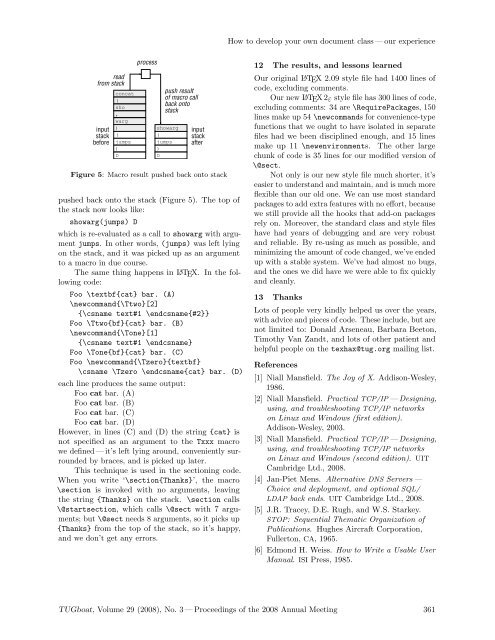The Communications of the TEX Users Group Volume 29 ... - TUG
The Communications of the TEX Users Group Volume 29 ... - TUG
The Communications of the TEX Users Group Volume 29 ... - TUG
You also want an ePaper? Increase the reach of your titles
YUMPU automatically turns print PDFs into web optimized ePapers that Google loves.
Figure 5: Macro result pushed back onto stack<br />
pushed back onto <strong>the</strong> stack (Figure 5). <strong>The</strong> top <strong>of</strong><br />
<strong>the</strong> stack now looks like:<br />
showarg(jumps) D<br />
which is re-evaluated as a call to showarg with argument<br />
jumps. In o<strong>the</strong>r words, (jumps) was left lying<br />
on <strong>the</strong> stack, and it was picked up as an argument<br />
to a macro in due course.<br />
<strong>The</strong> same thing happens in L A<strong>TEX</strong>. In <strong>the</strong> following<br />
code:<br />
Foo \textbf{cat} bar. (A)<br />
\newcommand{\Ttwo}[2]<br />
{\csname text#1 \endcsname{#2}}<br />
Foo \Ttwo{bf}{cat} bar. (B)<br />
\newcommand{\Tone}[1]<br />
{\csname text#1 \endcsname}<br />
Foo \Tone{bf}{cat} bar. (C)<br />
Foo \newcommand{\Tzero}{textbf}<br />
\csname \Tzero \endcsname{cat} bar. (D)<br />
each line produces <strong>the</strong> same output:<br />
Foo cat bar. (A)<br />
Foo cat bar. (B)<br />
Foo cat bar. (C)<br />
Foo cat bar. (D)<br />
However, in lines (C) and (D) <strong>the</strong> string {cat} is<br />
not specified as an argument to <strong>the</strong> Txxx macro<br />
we defined — it’s left lying around, conveniently surrounded<br />
by braces, and is picked up later.<br />
This technique is used in <strong>the</strong> sectioning code.<br />
When you write ‘\section{Thanks}’, <strong>the</strong> macro<br />
\section is invoked with no arguments, leaving<br />
<strong>the</strong> string {Thanks} on <strong>the</strong> stack. \section calls<br />
\@startsection, which calls \@sect with 7 arguments;<br />
but \@sect needs 8 arguments, so it picks up<br />
{Thanks} from <strong>the</strong> top <strong>of</strong> <strong>the</strong> stack, so it’s happy,<br />
and we don’t get any errors.<br />
How to develop your own document class —our experience<br />
12 <strong>The</strong> results, and lessons learned<br />
Our original L A<strong>TEX</strong> 2.09 style file had 1400 lines <strong>of</strong><br />
code, excluding comments.<br />
Our new L A<strong>TEX</strong>2ε style file has 300 lines <strong>of</strong> code,<br />
excluding comments: 34 are \RequirePackages, 150<br />
lines make up 54 \newcommands for convenience-type<br />
functions that we ought to have isolated in separate<br />
files had we been disciplined enough, and 15 lines<br />
make up 11 \newenvironments. <strong>The</strong> o<strong>the</strong>r large<br />
chunk <strong>of</strong> code is 35 lines for our modified version <strong>of</strong><br />
\@sect.<br />
Not only is our new style file much shorter, it’s<br />
easier to understand and maintain, and is much more<br />
flexible than our old one. We can use most standard<br />
packages to add extra features with no effort, because<br />
we still provide all <strong>the</strong> hooks that add-on packages<br />
rely on. Moreover, <strong>the</strong> standard class and style files<br />
have had years <strong>of</strong> debugging and are very robust<br />
and reliable. By re-using as much as possible, and<br />
minimizing <strong>the</strong> amount <strong>of</strong> code changed, we’ve ended<br />
up with a stable system. We’ve had almost no bugs,<br />
and <strong>the</strong> ones we did have we were able to fix quickly<br />
and cleanly.<br />
13 Thanks<br />
Lots <strong>of</strong> people very kindly helped us over <strong>the</strong> years,<br />
with advice and pieces <strong>of</strong> code. <strong>The</strong>se include, but are<br />
not limited to: Donald Arseneau, Barbara Beeton,<br />
Timothy Van Zandt, and lots <strong>of</strong> o<strong>the</strong>r patient and<br />
helpful people on <strong>the</strong> texhax@tug.org mailing list.<br />
References<br />
[1] Niall Mansfield. <strong>The</strong> Joy <strong>of</strong> X. Addison-Wesley,<br />
1986.<br />
[2] Niall Mansfield. Practical TCP/IP—Designing,<br />
using, and troubleshooting TCP/IP networks<br />
on Linux and Windows (first edition).<br />
Addison-Wesley, 2003.<br />
[3] Niall Mansfield. Practical TCP/IP—Designing,<br />
using, and troubleshooting TCP/IP networks<br />
on Linux and Windows (second edition). UIT<br />
Cambridge Ltd., 2008.<br />
[4] Jan-Piet Mens. Alternative DNS Servers—<br />
Choice and deployment, and optional SQL/<br />
LDAP back ends. UIT Cambridge Ltd., 2008.<br />
[5] J.R. Tracey, D.E. Rugh, and W.S. Starkey.<br />
STOP: Sequential <strong>The</strong>matic Organization <strong>of</strong><br />
Publications. Hughes Aircraft Corporation,<br />
Fullerton, CA, 1965.<br />
[6] Edmond H. Weiss. How to Write a Usable User<br />
Manual. ISI Press, 1985.<br />
<strong>TUG</strong>boat, <strong>Volume</strong> <strong>29</strong> (2008), No. 3 — Proceedings <strong>of</strong> <strong>the</strong> 2008 Annual Meeting 361

















